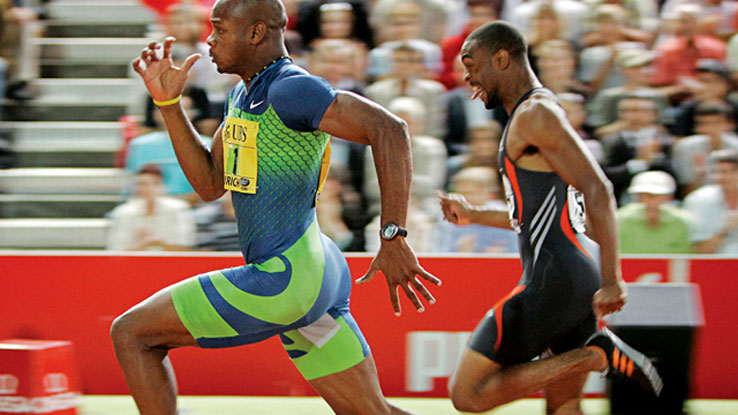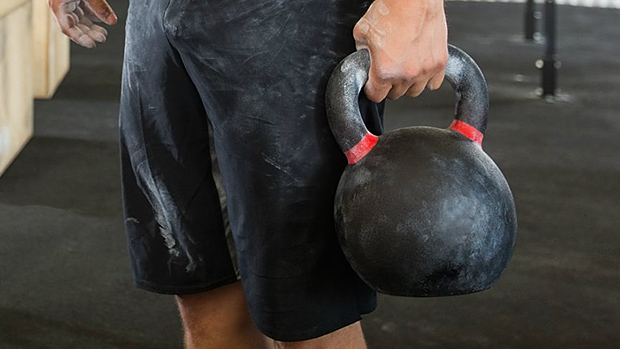Welcome to the 6-6-6 Sprinting Solution – the 6-week interval-training program that will radically alter your conditioning, increase endurance and power, and drop stupid amounts of body fat.
Interested? Well, before we get into the program, let me tell you how this all started.
I'm Getting Old(er)
It's true. I'm getting old...er. Less than six months from now I'll be 30, and boy does that feel weird. As I crest the rise of the hill leading the way into the twilight of my youth, I'm starting to realize what everyone has always told me is true: it sucks getting old.
Now, before those of you in the 40-50+ crowd jump all over me, let me say that yes, I'm completely aware that by most standards, I'm still quite young.
I guess I should amend my statement to say, "Things change as you get older." I think we can all agree on that, no matter how old we are.
As recently as five years ago, things were a bit easier. Fact is, things were a breeze, especially in the fat loss department.
When I was 21-24, man, I was a beast. I needed exactly three weeks – and three weeks only – to get ready for the summer. That meant if beach season started in June, I didn't really have to start prepping until sometime in May.
I didn't know how good I had it.
This year, I had to start my summer prep in late March. Even with my advanced fat loss workouts and my knowledge of diet, it still took me about 6-8 weeks to get into the extreme lean shape that I like to maintain for the summer.
To try to figure out what the deal was, I pulled out my training journals from the past several years and compared my summer prep.
The first thing that jumped out at me was my diet. I used to eat the same thing every damn day! The foods were all healthy and even tasted good, but my culinary limitations certainly put a clamp on any kind of variation.
But that wasn't the answer. While I enjoy a broader spectrum of foods today, my overall diet is very similar in terms of calories and macronutrients. I eat more foods, but I'm not eating more food.
If anything, my diet has gotten better. I know a lot more advanced fat loss techniques than I did five or six years ago, and have tweaked practices like intermittent fasting, cheat days, and carb/calorie cycling to achieve impressive transformations with hundreds of soldiers in the growing Roman Empire.
Looking more closely, the difference between what I did and what I was doing was sprinting. Back in the day, I used to sprint three times per week, without fail. Every. Single. Week.
Now, I sprint about once per week.
However, it's not quite that simple. While I sprint less often today, I've taken that into account in how I train today, and the added activity from my workouts more than makes up for it.
This led me to ask, "Is there something special about sprinting that helps me lose fat so quickly?
Only one way to find out, of course.

Return to the Track
The next week, I sprinted Monday, Wednesday, and Friday, doing traditional HIIT/Tabata style workouts. It went pretty well; felt a bit like Ol' Roman lost a step or two, but I guess I shouldn't expect to hold onto my 40-yard dash time forever.
I did this for two weeks. Then, Saturday morning of the second week, I got up and had a serious problem.
Or perhaps, I woke up, because I certainly didn't get up – I had a hard time getting up most of the day. My hamstrings, glutes, and lower back were killing me, although I'd been aggressively foam rolling and stretching.
I got some soft tissue work done – massage and ART – and thought I'd be good for Monday. I was excited to get back to it because, to be honest, I was getting leaner already. I guess there is something special about sprinting after all.
Well, Monday rolled around, and during my warm up, I damn near felt my hamstring pull off my femur. Why did this happen?
This brings us back to the "I'm getting older" matter. It means that I can't recover as quickly.
Add to that another problem: I'm too good at it.
Between football and track, I learned how to truly sprint, not just jog really fast. I know the techniques, I understand stride, and I'm a power-based runner.
All of which means that when I sprint, I do it correctly – I use a lot of muscle and generate a lot of force. While that's probably what makes sprinting so effective for me, it also makes it very taxing.
Herein lies the problem. Sprinting seems to have an almost magical effect on fat loss, but the better you are at it, the more careful you have to be. If you're an advanced trainee, there's a threshold that you can't cross without greatly impeding your ability to recover.
I set forth to figure out how I could fix it and get shredded like when I was a kid.
I did a lot of experiments, ranging from decreasing the length of my sprints and just doing more of them, to packing all my sprinting into one day (bad idea).
I managed to find what works the best – a happy medium of incredible results, paired with a set up that allows for total recovery.
I mean total recovery. Not only will this sprint set up allow you to recover in a way that it won't interfere with subsequent sprint sessions, you won't even mess up your weight training workouts – even if it's a leg workout on the same day!
The secret is frequency.
The more often you train, the better your recovery – to a point. You still need to rest. In this program, you'll be sprinting six times per week.
If this all sounds counterintuitive given my injury woes from sprinting three times per week, consider this little wrinkle: in training, whenever you increase frequency, you have to adjust but (not necessarily decrease) volume.
In a weight-training context, if you normally bench for ten sets on Monday and wish to increase your frequency, you could split up benching over two days, say five sets on Monday and Thursday.
Now, instead of just doing five sets on each day, you could try six. Your total volume goes up, but your daily volume goes down.
Taking it a step further, you could do four sets, three days per week. Finally, if you want to take it all the way, you could do three sets, five days per week. Your total is 15 sets – 50% more volume – but spread over a greater time.
Because you're resting and never hitting total exhaustion, you can actually perform more work over the week. Furthermore, you could also gradually increase the weight to increase results.
Understanding this principle, I began applying it to sprinting. And what do you know, it worked. Over the course of a few weeks, I came up with:

The 6-6-6 Sprinting Solution
- 6 sprints
- 6 days per week
- 6 weeks.
Bam. It's that simple.
Back when I used to do full sprint workouts three times per week, I'd perform 10 sprints per workout, for a total of 30 sprints per week. Each of these was a full-out sprint, lasting 20 seconds, with 10 seconds of rest in between.
Pretty obvious why it was so challenging, huh?
I decided to up the frequency and keep the volume moderate. I wanted to sprint every day, as I predicted that this would allow me to drastically lower the volume to allow for recovery.
After experimentation, I found that I could sprint six days per week with no issue.
Then came the volume. I began with five sprints per day, meeting my total of 30 sprints per week. At 20 seconds each, it would still be a challenge, but I thought I could do it.
Well, it worked for a bit, but I started to feel burnt out again.
I decided to look at volume a bit more deeply. I started looking at my total week work time; that is, my total amount of time spent sprinting.
In my initial model of three days per week and 10 sprints, I was sprinting for a total of 200 seconds per day, or 600 seconds per week.
In my first version of sprinting six days per week, that was simply divided over six days instead of three. That is, five sprints of 20 seconds for a total of 100 seconds per day, or a total of 600 seconds per week.
It was good, but I still felt like I wasn't recovering well enough. That's because, like you, I simply wasn't accustomed to daily sprinting. My legs needed more time to recover.
So it was back to the lab again, this time to see if the workload could be tweaked. I reasoned (correctly) that if I allowed myself to build up to the total time workload, I could not only achieve 600 seconds, but also perhaps more – all while burning fat and allowing for adequate recovery.
I switched the rest periods to allow for optimal recovery during each workout, giving me the "space" to make progress from week to week.
All told, this new program would give me the best of all worlds – the benefits of daily sprinting (constantly elevated metabolic rate, daily caloric burn), as well as built-in progression, meaning that while I'm forcing adaptation from increasing workload, I'm staying ahead of the adaptation curve.
Increases in fat loss, aerobic capacity, and overall athleticism. All with minimal time and a small daily commitment. Not too shabby.
Okay, enough talk. Let's get to the workouts!
The Triple 6 Workouts
- The number in the work column of the tables below represents your work time, and the number in the rest column is your rest time. If you see "10" and "20" in those columns respectively, that means sprint for 10 seconds and rest for 20 seconds.
- These workouts are done on a treadmill, which allows for convenience with both performance and timing. While you can do these as outdoor sprints, you'll run into the issue of clock-watching.
- Sprinting on a treadmill is a bit tricky. Be careful, and be sure to use the handrails as you jump on and off. When you're resting, simply grab the handrails and jump onto the side rails of the treadmill. To jump back on, grab the handrails and start sprinting again. Maintain your grip on the handrails for the first second or two.
- If you choose to train outside, my recommendation would be to sprint for distances instead of times. Take the given time and multiply it by 8; that's the distance you'll run in yards. So a 10-second sprint becomes an 80-yard sprint. Your rest period is the amount of time it takes to briskly walk or jog back to the starting point.
- Each week, do a single sprint workout, six days per week. The workouts are structured to be progressive, allowing each week to build on the previous week.
- f at any point you feel like the workout is too easy, simply increase the speed or incline on the treadmill – not the time. The time is how we measure progress week to week, so increasing your sprints because you feel strong one day is going to mess with the program.
- Ideally, do these workouts first thing in the morning. If you're going to be training in the morning, sprint first and train after.
- Stretch before and after. Stay hydrated. Insert other disclaimers. Don't be an idiot and hurt yourself.
On to the show!
Week 1
| Sprint | Work | Rest | Sprint | Work | Rest |
|---|---|---|---|---|---|
| 1 | 20 | 10 | 4 | 20 | 10 |
| 2 | 10 | 20 | 5 | 10 | 10 |
| 3 | 15 | 15 | 6 | 10 | 50 |
- Cooldown: 4 min walk
- Optional: 15 min incline walk for extra fat burning
- Total Sprint Time for the Workout: 85 seconds
- Total Sprint Time for the Week: 510 seconds
Notes on Week 1: You'll notice that in this week you're sprinting for a total of 510 seconds, which is a great start. However, the important part here is the set up. You're never going to dig yourself into too deep of a hole, because the rest periods are structured to allow you a nice bit of recovery.
There are only two sprints lasting 20 seconds – one when you're fresh, and one when you've rested for a "long" period of 15 seconds. More importantly, each of those 20 second sprints is followed by a short sprint of only 10 seconds. This short follow up sprint won't tax you too much, so you can recover more effectively on subsequent rest periods.
Overall, this will break you in and allow for some nice fat loss. Week one is also a good gauge of where your weaknesses may reside.
If at the end of the workout you're winded, we've got some issues and you should repeat this. On the other hand, if you're not winded but having trouble closing out some of the sprints, that may be an issue with local fatigue, and will work itself out over the week.
Week 2
| Sprint | Work | Rest | Sprint | Work | Rest |
|---|---|---|---|---|---|
| 1 | 20 | 10 | 4 | 15 | 15 |
| 2 | 10 | 20 | 5 | 15 | 15 |
| 3 | 15 | 15 | 6 | 10 | 50 |
- Cooldown: 4 min walk
- Optional: 15 min incline walk for extra fat burning
- Total Sprint Time for the Workout: 85 seconds
- Total Sprint Time for the Week: 510 seconds
Notes on Week 2: During the second week of the program, you'll notice that your total sprint times are the same. Where's the progression from week one?
While your work time is unchanged, the structure of the workouts is what makes this a bit harder. You only have a single 20-second sprint here, followed by a short 10-second sprint. However, from there you have to deal with three 15-second sprints in a row, all with equal rest periods. This forces higher performance with less rest.
While you're not doing more overall work than Week 1, you're allowed less recovery during the latter part of the workout. This will help increase work capacity and prepare you for more total work in the coming week.
Moreover, having multiple "long" sprints helps build local endurance in your legs, ensuring that as you progress in the program, tired legs won't hamperyou.
Week 3
| Sprint | Work | Rest | Sprint | Work | Rest |
|---|---|---|---|---|---|
| 1 | 20 | 10 | 4 | 15 | 15 |
| 2 | 15 | 15 | 5 | 15 | 15 |
| 3 | 15 | 15 | 6 | 10 | 50 |
- Cooldown: 4 min walk
- Optional: 15 min incline walk for extra fat burning
- Total Sprint Time for the Workout: 90 seconds
- Total Sprint Time for the Week: 540 seconds
Notes on Week 3: This week, we progress in a few different areas.
First, you'll notice that the total work time increases to 90 seconds of total sprinting per day. While five seconds may seem a small difference, when we're talking sprints, every little bit helps.
Looking at the structure, you can see how the difficulty will escalate. The short 10-second sprint and 20-second rest combo is gone, meaning that your longest rest period is now at the very end of the workout.
Instead of being able to recover to any real degree, you jump into 15/15 alternations for the majority of the workout.
Although it's only a 1:1 work/rest combo, it's still physically exhausting and serves to improve cardiovascular endurance while burning fat.
This also begins to draw on the enhanced local endurance in your legs that was built during the first three weeks.
Week 4
| Sprint | Work | Rest | Sprint | Work | Rest |
|---|---|---|---|---|---|
| 1 | 20 | 10 | 4 | 10 | 20 |
| 2 | 20 | 10 | 5 | 15 | 15 |
| 3 | 10 | 20 | 6 | 15 | 45 |
- Cooldown: 4 min walk
- Optional: 15 min incline walk for extra fat burning
- Total Sprint Time for the Workout: 85 seconds
- Total Sprint Time for the Week: 510 seconds
Notes on Week 4: Again, we have a week where there's no increase in total training volume, but rather changes in structure.
Week 4 introduces the first appearance of two 20-second sprints back to back. This is exceptionally challenging, particularly with only 10 seconds of rest in between.
Thankfully, by this point you have a lot of experience with doing 15-second sprints back to back, so you're prepared for it.
The structure here is hard in the beginning, then a bit soft in the middle – two 10-second sprints with 20 seconds of rest isn't hard.
In many ways, this week is almost a "deload" week. It's easier than previous weeks, and serves to prepare you for the upcoming long sprints back to back.
Week 5
| Sprint | Work | Rest | Sprint | Work | Rest |
|---|---|---|---|---|---|
| 1 | 20 | 10 | 4 | 15 | 15 |
| 2 | 20 | 10 | 5 | 15 | 15 |
| 3 | 10 | 20 | 6 | 15 | 45 |
- Cooldown: 4 min walk
- Optional: 15 min incline walk for extra fat burning
- Total Sprint Time for the Workout: 95 seconds
- Total Sprint Time for the Week: 570 seconds
Notes on Week 5: This week workload goes up again, but that's not the only way things get more difficult.
Along with increasing sprint time to 95 seconds per day, you're also packing the seconds closer together with less rest.
As with Week 4, the long sprints are in the front; however, this time you only have a single 10-second sprint/20 second rest combo, followed by three 15/15 bouts to finish off the workout.
You're being forced to increase work output with diminished recovery time. You'll never fully recover, and each sprint will take it out of you, making subsequent sprints even harder.
Of course, the end result is increased fitness and decreased fatness.
Week 6
| Sprint | Work | Rest | Sprint | Work | Rest |
|---|---|---|---|---|---|
| 1 | 20 | 10 | 4 | 15 | 15 |
| 2 | 20 | 10 | 5 | 10 | 20 |
| 3 | 15 | 15 | 6 | 20 | 40 |
- Cooldown: 4 min walk
- Optional: 15 min incline walk for extra fat burning
- Total Sprint Time for the Workout: 100 seconds
- Total Sprint Time for the Week: 600 seconds
Notes on Week 6: This week, we finally get to the goal of sprinting for 100 total seconds per day, totaling 600 per week.
However, unlike my first shot at this, you won't be burned out because you'll have prepared for it over the previous weeks – while losing fat!
With Week 6, it's all work and no play. You've got two 20-second sprints in the front. This time, there's no 10-second recovery sprint followed by 20 seconds of rest.
No sweet air – just a double dose of 15-second bad boys to follow it up.
After that, you finally get a break with a 10-second sprint. After 20 brief seconds of rest, however, you're right back into the grind, finishing out strong with a 20-second sprint of agony.
By the end of the workout you'll be cursing my family for six generations in either direction. You'll also be burning fat and getting into the best cardiovascular shape of your life.
Week 6 can be performed for up to two additional weeks (stretching the program to a total of 8 weeks) before you need to take a week off and rest.
Provided you practiced some dietary diligence, by this time you should also have an adorable litter of six round and fuzzy abdominal muscles snuggled up neatly above your belly button. In honor of the efficacy of this program, please name the cutest of the bunch Roman.
Other Training and Odds and Ends
Of course, you'll want to do some other training outside of just sprints during the next six weeks, so it's important that we briefly cover that.
While the 6-6-6 program can be done in concert with nearly any training program, some are a better fit than others. The best training program would be a full body fat loss workout, done 2-3 times per week.
First, a fat loss workout is going to help maximize the effects you're looking for with the program in the first place (duh). Second, a full body program is very much in the same vein as the 6-6-6 program itself – frequent stimulation, but lower daily volume.
This means that you can do a full body program with no modifications, despite the fatigue and compromised recovery you're likely to have from the sprinting.
Here's the workout I recommend while following the 6-6-6 Sprinting program:
| Exercise | Sets | Reps | |
|---|---|---|---|
| A1 | Barbell Push Press | 1 | 8 |
| A2 | Pull-up with 2-second pause | 1 | 6-8 |
| A3 | Alternating Dumbbell Lunge * | 1 | 8 |
| A4 | Single-Leg Glute Bridge with 3-second pause * | 1 | 8 |
| A5 | Bodyweight Plank | 1 | 45 sec. |
| A6 | Dumbbell Floor Press | 1 | 12 |
| A7 | Bent Over Barbell Row | 1 | 10 |
| A8 | Goblet Squat | 1 | 6-8 |
* per leg
Rest 10-20 seconds between exercise.
Perform this circuit four times, resting 2-3 minutes between circuits.
Remember that despite the short daily workout, sprinting is taxing, and should be given top priority, at least for six weeks. Therefore, while the above workout is effective, it's designed to work alongside the sprints, which is why the leg volume is toned down. As long as you choose appropriate weights and move briskly, this brief circuit will shred off fat while keeping your strength levels up.
For those who wish to continue on with their regularly scheduled training, the obvious modifications concern leg training.
First, on days where you train legs, sprinting will be optional. If you choose to sprint on your leg training days (masochist), sprint first and reduce your weights. Period. Don't be a tough guy, and don't think you're smarter than ol' Roman. Reduce the weight, and do the sprints first.
The other mandatory change to make is to avoid sprinting the day after your leg training. You need one day to recover. Take that time to stretch, do some extra foam rolling, and read my blog.
Wrap Up
In a perfect world, we'd all grow old gracefully and become more distinguished versions of our youthful selves while not losing an ounce of our youthful athletic ability; like George Clooney with Reggie Bush's six-pack and 40-yard dash time.
Unfortunately, Father Time catches up with all of us, and while we can't stop the clock, we can slow that fucker down some. Sprinting – along with other activities that require natural athleticism – is a great place to start.





